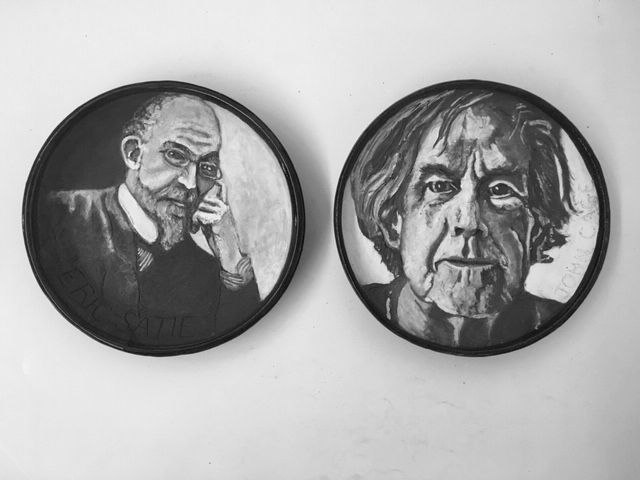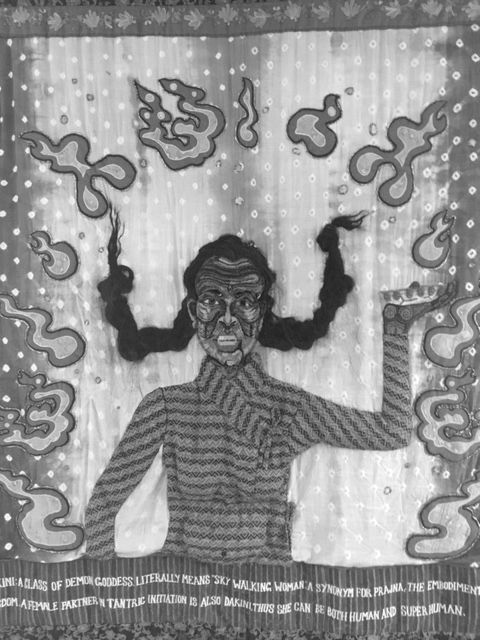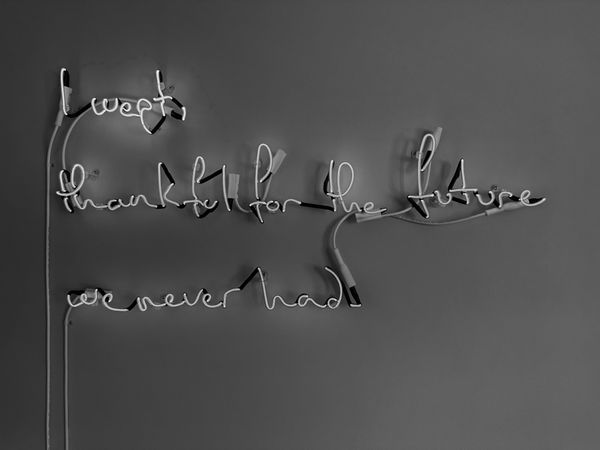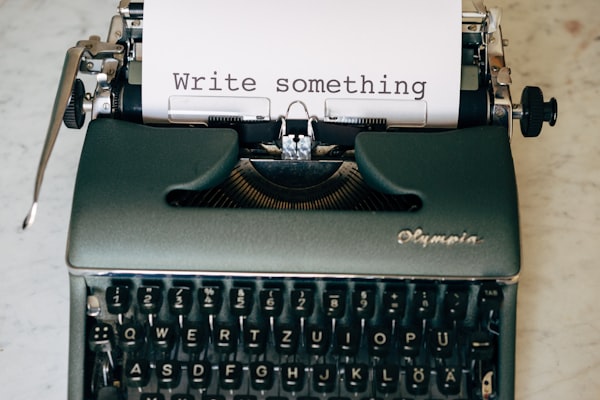Hot Rats an excerpt of a fsm. Interviews: with Frank and Lynn Zetzman
Frank Zetzman: ...Well, as you said, I’m a sculptor—predominantly working ceramics—and a drawer. Pastel, Conté, ink, charcoal...maybe the most consistent thing that I do is draw. It sort of dictates where I go with my pieces.
While my work changes quite a bit, it does tend to be representational of a sort— based on natural objects—or the figure. I generally work in a series, until it starts to run its course for me, or I run out of gas with it.
For this show I was working sculpturally, with two groups of works. One were these organic pods that are based on poppy seeds. I really liked the group of them, more than I liked them individually. I thought, as a group, they start having aviary looks to them, maybe a bunch of chickens. They also look like flowers, or a garden. I liked that part a lot. I’m not trained as a potter, and I’ve done very little pottery in my life besides demonstrating for my students. I had one ceramics class as an undergrad. Although I think that had I stayed in that medium I would have been able to expand out, but I gravitated towards sculpture and drawings.
When I got out of undergrad school, working on sculpture at that time, I was really wondering what the purpose was. And so, alone in the studio of my own, and I just began drawing. And the drawing had this sort of a funkiness to it. It was figurative fantasy, like surreal. A kind of a Midwestern surrealism. But I really longed to get back into sculpture.
I was set to go to graduate school, and Lynn and I were together taking a primitive fire workshop in Northern Wisconsin. I started building some work there and I thought this is the material I can get into and get back into sculpture.
After school, I got an instructor job right away. I’ve taught at a two-year campus my whole career, some 35 years, and teach there I have to be a generalist. Drawing, including life drawing and anatomy, ceramics, and sculpture in multiple mediums: steel, wood, plaster modeling and cold casting. It really dictates a lot of what I’m doing. The work I’m doing now are those pods and portrait relief plates. I started throwing plates and, just as a demo, I drew on one of the plates one day in my beginning drawing class. We were working with the figure and I grabbed some demo pots I had thrown and I first drew on those and then painted them with underglaze. I got really excited about the possibility. Now I’d already began the pod forms, and I thought oh, this could be really nice. I’d like to investigate this.
For the plates, I chose to paint portraits of composers. I love music. I play guitar and sitar. I decided to illustrate my 50 favorite classical-based composers for the plate series. I really like contemporary classical, although there’s two 19th century composers in the series. I did do a Wagner plate that I had no intention of doing at first, but driving home from Minneapolis, a Wagner opera was on public radio’sLive From the Met. And I was just so excited and thought: Oh, he’s gotta be part of the fifty. But mostly it’s 20th century or 21st century composers. A lot of classical composers are interested in rock, jazz and other forms, but they are trained classically. And that was my criteria: that they have to have been trained as classical musicians if I was going to make a relief plate on them.
Now, both the pods and the plates were the first time I’ve really used thrown work for my own work. The pods are made out of different thrown shapes put these plates, it’s really important to me that I throw the plates on the pottery wheel. So I’m making pottery and then I’m altering it into a sculptural form and then painting the plates with colored slips. I’m working with a red clay, so there’s a red-brown base, and then I’m working with a white under-glaze on top of that. It really looks like my Conté drawings, actually. Then I further embellish it with black and use glaze on certain areas to contrast the matte look of the underglazes. It really looks like tempera, or a very matte acrylic paint, which I then juxtapose that with the glassy surface on the rims and the backs. Finally, I’m randomly choosing some quote that I’ve either read. At first it was just things I was reading, but then I realized I can Google this. I’ve got all these quotes from these composers to lift.
[speaking on some of the composers he chose to illustrate for the series] I love Steve Reich’s music and I love 12-tone music as well, like [Arnold] Schoenberg and [Alban] Berg’s. Then there is Erik Satie’s piano pieces. There’s nothing like them for their era, the beginning of the 20th century. I just think it’s fantastic music. And then, John Cage. When I first heard I was, oh, I don’t know, maybe, 20 years old. I first heard the prepared pianos from this album that I bought. The piano was “prepared” by altering it with placed nuts and bolts. He did it because at first he was trying to make a percussion instrument out of it, like a Japanese gamelan sounding instrument. And for the piece with Merce Cunningham’s dance troupe, and he just tried putting plates in the inside of the piano that bounced around. That is when the idea came to him that he could put nuts and bolts and different things in between the strings, and make an incredible percussion instrument out of it. I was totally fascinated. The quotes are on the back of the plates. John Cage, of course, he’s known for four minutes and 33 seconds of silence in three movements. And so just tongue in cheek wise, I gave him three lines with no voice coming out.
Two of Frank Zetzman’s plates. On the left is a portrait of John Cage. Right, the reverse of the Schoenberg plate. The inscription reads: “If it is art, it is not for all; and if it is for all, it is not art.” Arnold Schoenberg
Lynn Zetzman: Thank you for the magazine [fsm.] for trying to engage a dialogue among creatives in the Fox Cities, and perhaps broaden the audience for the arts. I think that there’s a better environment for a variety of art mediums in the Valley since we moved here in the late eighties. And I appreciate that growing audience and your efforts to enlarge it as well.
So, I’ve always loved art. I’ve been drawing from the time I was a very small child. I got a lot of very positive feedback for it, and even before I was in school people could recognize the images and they seemed excited about them. I think there is a real excitement when you can create something that gets a reaction from an audience, but also on a very personal level, just appreciating that you can be a creator. As I’ve aged, that element of it has really grown. I think we’re in this really mad consumer society and it’s always like more, more, more...and people are more consumers than they are creatives. I love textiles. I have some books of the history of textiles in America, and they talk about how every woman would weave, spin and create the textiles for their family.
I’m a teacher. I’ve taught K-12, art methods at Lawrence, and I’ve been at Xavier high school for 27 years. I taught at grade schools in the cities, and before that I taught K-12 at Reidsville public schools. I taught Marshfield Columbus High School. We moved around a little bit. I had students who would come to me who had used a hammer and different tools at home. And, in recent years, that’s not been the case. I appreciate my ability to make more and more in this kind of over the top consumer society.
I started to sew when I was nine years old. My mother thought it would be a good idea. She signed me up for 4-H, and my very first a sewing project was an had grandmothers who were wonderful makers as well and one grandmother taught me how to make curtains. My other grandmother taught me how to make lampshades. I just always loved the making part of it.
My father brought me up to the university to go to school. We drove up to Eau Claire from the Milwaukee area. He said to me that I didn’t have to do this to please him. [Laughing] He wasn’t paying for it, first of all. But, he, you know, he said to do what I wanted to do, and to do it for me.
I didn’t know what I was going to study, but my very first semester I took a Egypt art history class, and I just fell in love. And this is what I had been interested in as a child all the way through my high school years and I just thought, okay, I’m going to go for it. Never thinking about a job. My undergrad degrees were in studio arts and art history, because I just took what I wanted to take. I wasn’t thinking about trying to make a living from any of it.
I met Frank and undergraduate school. I think we met in an Art History Since 1950 class. Really appreciated him as a maker. His work was very different than mine. I tend to sort of like faux-naïve look, and I’m fascinated by outsider art and folk artists. They just have this compulsion to make, without having to have this sort of strenuous academic background. That really moves and motivates me that there’s some kind of popular impulse to create. Frank always liked Modernism you know, which I had thought was kind of a yawn or a snore—this Russian constructivist work. And he really helped me to appreciate it. That was a real gift to me. Instead of disregard something as boring that by talking about it, he would open it up for me and helped me to appreciate it.

So we’ve always been an audience for each other. I think that that’s been a real gift, but also maybe it has made us sort of complacent. Like we didn’t have to push ourselves for a greater audience because we, you know, we have each other in this sort of making adventure over all of these years.
I said that I started to sew as a child. When I was in college I had a professor who told me that the very best art was personal, but touch universal. So I thought, okay, what’s personal? And I thought, this making of things with fabric. It was a time in the early seventies when feminism was becoming more popular. It had started earlier, but with the social upheaval that happened in the sixties and into the seventies it was certainly more in the public view, so that a small town, rural Wisconsin girl, was very aware of feminism. I certainly had friends who thought, okay, I’m going to weld sculptures and you know, I can do whatever I want to do. Women shouldn’t be limited. And I just thought I wanted to celebrate what women had done through the centuries. They had this connection with textiles and I wasn’t going to throw the baby out with the bath water. I was going to embrace this kind of work.
I do make narrative quilted “Wallwork,” and have for many years. The hats are a newer series that have happened over a three-year period. I worked making one hat a month for 12 months, which had originally been my goal. And then I stopped for a year. And I started it up again. I like the hats. A lot of the quilts would take me 1,000 hours to make. The one that shared a picture of is entirely hand-sewn. There’s no machine work with it at all. The hats are also all hand-sewn. I don’t use the sewing machine with them. The hats take 120 hours, it’s still a long time. Some, maybe not quite so much. I think one only took me 80 hours and the one that took the longest was like 120 hours. I really like that kind of slowness to the making of my textile work. Again, I’m slowing things down. It isn’t this kind of rat race thing that I was talking a little bit about earlier with my pride in being a maker, not just a consumer. So instead of producing, you know, tons this way, I get to produce a smaller amount of things.
A quilt of Lynn Zetzman’s.
We begin to go through the slides again for the online talk and I bring up an image of twelve small dolls, each holding a sign that says, in various typefaces, “VOTE.” The dolls, placed on a Appleton city street, are all wearing handmade clothing, including “pussy” hats.

Cristian Andersson: So when did you do these?
Lynn: I did those this fall. Part of the inspiration for it came from 2016, when I went to the Women’s March in Madison. It was a really joyful experience for me, getting together with all of these women. I made many of the pink pussy hats, and gave them to friends. I sent four hats to DC for the big Women’s March. I kind of wanted to bring back the energy that I felt at the Women’s March. Thinking aboutthis upcoming election cycle...this isn’t quite over. On the 7th of April, when we were supposed to vote [this was the date of the Spring Election in Wisconsin], I think a lot of people didn’t go vote because of the stay at home order and the corona virus. A lot of people applied for absentee ballots. Our daughter did, she applied before the deadline, and it didn’t arrive until after the election. I’m going to be making a plague doctor puppet and he’ll be facing these women. So this isn’t this piece isn’t quite done.
We look at a slide that shows Frank’s studio, and he talks about some of the pieces visible in the photograph. On the floor of the studio are large, disc-shaped pieces with dioramas embedded on the top, to the right are some of his poppy/pod forms, and in the back are some ceramic pieces that resemble turtle carapaces.
Frank: I worked about five years on these landscape pieces [referencing the disc- shaped ceramic pieces]. I’ve sort of done two bodies of landscape work over the last 35 years. I first started by building these pieces that I suspended into drop ceilings which, when you looked up, seemed like you were looking underground. They ran their course, and I didn’t know that I would go back to landscape at all in sculpture. One of the things you get in ceramics is leftover clay buckets sitting around. And I

had my students doing a theme of variation on plates: make plates and do theme variations on them. Well, I saw these dried clay forms in these slurry buckets, and I just loved them. I fired him. I started to paint them and from there they really morphed into something else quickly. I’d add little embellishments, and I’d play with scale. It gives an indication of what size I’m imagining the thing, rather than the size being somewhat ambiguous.
And then they’re salt fired, which is really a technique that one of my major professors made a Renaissance of in States really—Don Reitz. I built a salt kiln at UW-Fox. And, on the left is a turtle shell [referencing the image]. Again, a whole body of that work. They were abstractions, obviously the inside of the turtle shell. I like bones and stuff. First job I ever had in undergraduate school was I worked for Allied Health Department, and the first set of drawings I had to do for them was rat control and housing. Rats sort of become a humorous symbol for me.
This is an excerpt from a much longer interview with Frank and Lynn Zetzman, which was our first of the fsm. Interviews series. The talk was held on May 7th, 2020, and is archived to our YouTube channel, along with five other interviews.
Our YouTube channel is at: https://bit.ly/3oaf51E
fsm. Interviews is a way that we are able to continue making connections between artists and the community. In May we found it difficult to get our journal into the hands of readers. COVID-19 was a major health threat then, and it is even more so today in the United States. For the next few months, we will fall back into hosting fsm. Interviews online and suspending the production of the print journal.
If you would like to find out about future fsm. Interviews, you can subscribe to our newsletter at: http://eepurl.com/hkgayX




